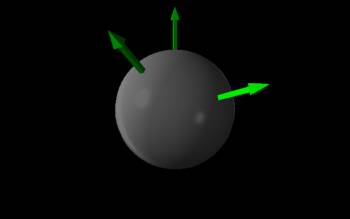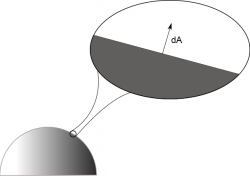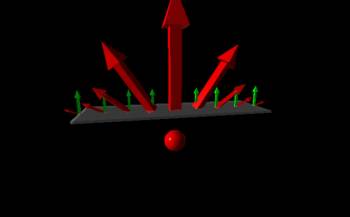−Table of Contents
Section 21.3 from Matter and Interaction (4th edition)
Electric Flux through Curved Surfaces
We talked already about how to calculate the electric flux through a flat surface and through an enclosed cube for a constant electric field. But what happens if the field is not constant? Or what if the surface is no longer flat? These notes will show how we modify the electric flux equation to account for varying fields and curved surfaces.
Curved Surfaces
Area Vectors
Before we said that for a flat surface, the area vector is given by the magnitude of the area times the vector that points perpendicular to the area. This makes sense for a flat surface, where the area vector will point in the same direction for all points on the surface. However, for a curved surface, this no longer makes sense. It becomes impossible to use a single vector to describe the surface.
But if we zoom in on a very small piece of the area (call this dA), this extremely small area will appear to be flat. Thus, we can write the area vector for this very small piece of area using our normal rule. Namely, that the vector for the very small piece of area (d→A) will be equal to the magnitude of the small chunk of area (dA) times the vector that is perpendicular to that small chunk (ˆn): d→A=dAˆn
For example, take a hemisphere shell as a surface area. On the very top of the hemisphere, the little piece of area is horizontally flat, so the d→A at this location would point straight up. If you move to either side of the top of the hemisphere, the dA would be locally flat (tangent to the hemisphere surface), so at that location, the d→A would point perpendicular to the surface. No matter where you pick as your dA, the d→A should point perpendicular to that small piece of area. In the case of the curved part of a hemisphere (or a whole sphere for that matter), the d→A's all point radially away from the center of the sphere. So we could write any general d→A for a sphere as: d→A=dAˆr
Electric Flux
To find the electric flux then, we must add up the electric flux through each little bit of area on the surface. In terms of calculus, this would mean we first would write the little bit of flux (dΦe) as the cross product of the electric field through the little bit of area (→E) and the little area vector (d→A): dΦe=→E∙d→A
Making Use of Symmetry
When we look at this equation for flux, there are two places where symmetry can make our calculations much easier. First, we want to simplify the dot product - either by picking surfaces with d→A's that are perpendicular to the electric field (giving zero flux) or by picking surfaces with d→A's that are parallel to the electric field. If everywhere along the surface the d→A is parallel to the electric field, then the dot product turns into a normal multiplication of the vector magnitudes: Φe=∫→E∙d→A=∫EdA
- parallel d→A's to the electric field
- constant electric fields along the surface.
As an example, let's look at the electric field from a positive point charge, which points radially away from the point charge (shown by the red arrows). If we imagine a rectangular plane above the point charge, then the electric field vectors that would point through that plane would both change direction and change in magnitude all over the surface. Since the electric field vectors have different directions all over the plane but the dA vectors all point up for the plane (shown by the green arrows), this means we cannot easily simplify the dot product in the electric flux equation. On top of that, the electric field is not constant along the plane since the magnitudes of the vectors change. In this case, the integral to find the flux would be extremely difficult and would need to account for the changing angle of the vectors and the changing size of the field (aka we do not want to do that).
Instead, imagine a spherical shell or bubble around the point charge. In this case, the d→A's would point radially outward from the bubble at every point along the surface (again shown by the green vectors). Likewise, for every dA, the electric field points radially away from the point charge (shown by red arrows). This means that the d→A is always perpendicular to →E for a given location, so we can simplify the dot product to a simple multiplication. Φe=∫→E∙d→A=∫EdA
Thus, we want to pick surfaces that have high amounts of symmetry with our charge distributions because this will make our calculations of electric flux much more doable.
Examples
-
- Video Example: Flux through Two Spherical Shells



